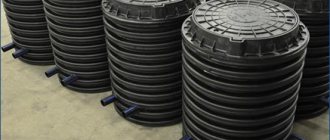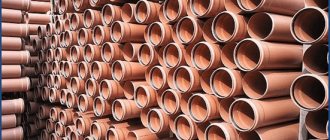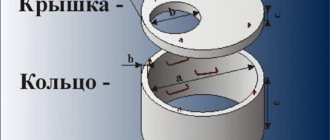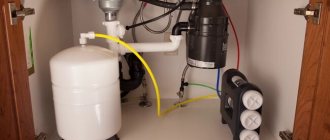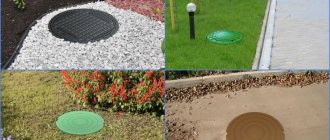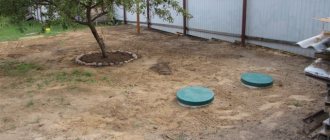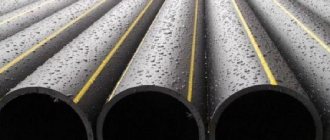The technology for constructing a drainage system involves the installation of wells that differ in purpose. They are needed to monitor the operation of the underground pipeline, regular maintenance and periodic cleaning. Previously, they were assembled from concrete rings, but now products made from polymer materials are used.
Lightweight and durable plastic drainage wells greatly facilitate the process of constructing the system. Polymer products are resistant to mechanical, chemical and biological influences. Product manufacturers have thought through all the details to ensure simplicity and high speed of installation.
We will tell you how to wisely choose polymer structures for a drainage system and how to install them. The article presented for review contains step-by-step instructions in detail. By following our advice, you can quickly install effective drainage in your suburban area.
Types of drainage wells
The most popular are plastic drainage wells, which differ in:
- strength;
- reliability;
- light weight;
- long-term operation;
- resistant to rotting, corrosion, and aggressive chemicals.
But plastic tanks differ in their design and scope of application.
Rotary wells
They are installed above the places where the pipeline turns. These are vulnerable drainage areas where clogs are most likely to form. Accordingly, the main task of such containers is to provide access to clogged drains. Installation of rotary-type plastic drainage wells is also carried out in places where several pipes converge, at every second turn of drains and in the corners of the house.
Inspection and inspection wells
They are used for timely and regular inspection and monitoring of the efficiency of the drainage sewer system. Most often requested:
- after a network failure;
- intense precipitation;
- floods;
- impacts of other climatic and anthropogenic factors;
- for system maintenance, for example, preventive flushing of pipes.
Installation of inspection wells is usually carried out in places where several pipes converge, and on a straight section of the pipeline - every 30 m.
By their design, inspection wells can also perform the functions of rotary wells.
Absorption wells
They are also called filtration, filtering. They are used in cases where, for a number of reasons, it is impossible to discharge the wastewater collected by drainage into the general sewer system. These are products without a bottom, which, due to the filter layer, contribute to the natural removal of wastewater into the underlying soil layer. If the water receiving layers lie too deep, the system will have to be supplemented with a drainage well.
Installation of a plastic absorption type drainage well is carried out as follows:
- A hole is dug with a depth of 2 m or more.
- The bottom is covered with sand (which needs to be compacted), and then with a filter layer of crushed stone.
- The well itself should be wrapped with geotextile on the sides.
- A plastic well (looks like a perforated pipe) is installed on the prepared filter layer and the gaps between the tank and the pit are filled with gravel.
Having completed these steps, you can use a ready-made structure that will drain water from the drainage system naturally into the ground.
Storage wells
They are also called water intake or collector. Such wells are used mainly to collect runoff from drainage pipes into one container, so that they can later be used, for example, for watering a garden or for pumping into a nearby ditch. Also, collector wells are installed in areas where the soil capable of receiving water is located too deep, which makes natural drainage of wastewater using a filtration well impossible.
If we consider the design of this tank, then the storage well is a sealed container, which is the end point of a closed drainage system. The volume is determined depending on the design features, purpose of the tank, as well as the expected volume of water received. When installing this well, corrugated pipes with a large diameter are used, as well as a submersible pump if water is supposed to be pumped out for technical needs.
Ideal alternative to concrete rings
Until recently, reinforced concrete rings were used to construct drainage wells. This material also perfectly withstands physical stress and is capable of long-term use.
But the plastic well for drainage is gradually replacing this traditional method. And all thanks to its qualities.
You cannot work with concrete rings yourself. Proper installation will require the use of special construction equipment, which is simply impossible in some areas. Concrete ring joints are quite difficult to make waterproof.
This may require high-quality cement mortar with the addition of liquid glass. In addition, the concrete must be coated with bitumen mastic both outside and inside. This will bring the well made of reinforced concrete rings closer to the desired tightness.
All this work will not be required if you use plastic products for storm drainage. The speed of work, quality and long-term operation make polymer wells an ideal solution to the problems of constructing drainage systems.
Construction of a plastic drainage well
The drainage well consists of the following typical elements:
- a sewer hatch through which access to the underground part of the communications will be provided;
- the neck is a load-bearing element, but it can be abandoned if drainage wells are installed in pedestrian areas;
- shaft - the main part of the well structure;
- bottom - responsible for collecting sediment (sand, silt), but this element is not provided in absorption wells.
Some models can be increased in volume by attaching additional rings.
Functions and design
Wells are key elements of the drainage system, responsible for several tasks at once: directly collecting water, connecting discharge pipes at level differences and turns, checking and maintaining the pipeline, and redirecting water.
Without these devices, the system will simply be non-functional and short-lived. In addition, the lack of wells can negatively affect the condition of the serviced local area. Despite their multitasking, drainage wells have a fairly simple structure. The basic design includes the following elements:
- The bottom is the base of the well. Solid particles of dirt and sand settle here, coming through drainage pipes along with water. Sometimes a drainage pump is installed in the bottom area.
- The corrugated chamber is the central part of the well. Resembles a tall glass or an extended pipe. The diameter of the central chamber must be at least 30 cm, and the length must be at least 100 cm. At a distance of 40-50 cm from the bottom, there are holes in the chamber for incoming drainage pipes.
- The sealed lid is the top part of the well. Protects the device from overloads that can be caused by rainwater entering it.
Installation of a drainage well
Plastic drainage units are made from different polymers. It can be polypropylene, polyethylene, polyvinyl chloride or their derivatives.
Diameter of plastic drainage wells
The selection of wells is made according to the following principle:
- for rotary wells, a diameter of 0.34 - 0.46 m will be sufficient;
- for the inspection room, if in the future a person will be lowered inside to service the system - about 1 meter, but if the wells are simply inspected and superficially cleaned - then the diameter can be 0.34 - 0.46 m;
- filter wells begin their size range from 0.69 m or more, which depends on the volume of water that the reservoir will receive and discharge into the ground;
- collector or storage tanks are selected taking into account the nuances associated with the removal of accumulated water - either this will be the task of the sewer trucks, or the wastewater will be discharged by gravity into the nearest ditch.
All these nuances are worked out at the design stage of the drainage system. Therefore, the choice of diameter will be made taking into account not only whether a person will descend into the tank, but also what volume and type of wastewater needs to be removed from the ground and where to discharge it.
Selection of pipe sections
Next, we determine the cross-section of the pipes, which will depend on their future slope. Based on the cross-section and volume, which is determined using the above formula, we can determine the required diameter.
| Slope, % | Diameter | ||
| 10 cm | 15 cm | 20 cm | |
| 1,5-2 | 10,03 | 31,53 | 77,01 |
| 1-1,5 | 8,69 | 27,31 | 66,69 |
| 0,5-1 | 7,1 | 22,29 | 54,45 |
| 0,3-0,5 | 5,02 | 15,76 | 38,5 |
| 0-0,3 | 3,89 | 12,21 | 29,82 |
If one pipe is connected to several gutters at once, then to determine the diameter you simply add the numbers for each of the flows. We will calculate all other elements of the system - trays, gratings, funnels, etc. in the same way as pipes. These elements, made of plastic, are sold in all stores today. If desired, you can order parts from a mechanic - he will make them from galvanized sheet.
Installation of plastic drainage wells
The installation of the well is carried out according to the following scheme:
- The pipe, which was purchased for installation as a tank, is cut to the specified depth of the well.
- Step back 50 cm from the bottom edge, cut holes for connecting drains. Seals are inserted into them.
- The bottom of the well is secured using sealant or mastic.
- The foundation pit is being prepared. To do this, dig a hole of the required depth. Its diameter should be 40 cm larger than the well.
- At the bottom there is either a sand cushion or a concrete lining.
- Drains are connected to the well.
- If this is a perforated filtration well, then you will need to first wrap the product in geotextile. Next, the space between the well and the pit wall is filled with a mixture of sand and gravel.
When all activities are completed, the finished well is covered with a hatch. The last step is to compact the soil around the well, after which a cement frame is made.
Installing a plastic drainage well is a fairly simple matter, so it does not cause any difficulties. The main thing is to choose the right type and diameter of the product according to the project and the characteristics of the area. You can always turn to Europlast consultants for help, who will help you purchase the products you need.
How do you know if a well needs cleaning?
Periodic cleaning of a well from contaminants is a necessary measure, the execution of which determines the quality of drinking water. If the well is shallow, you can clean it yourself without resorting to the services of specialists. But how do you know when it’s time to clean your well? There are several signs by which you can accurately determine that a well needs cleaning. Let's look at them in more detail:
Polluted well
- decrease in water level;
- the occurrence of clay deposits;
- the appearance of various debris in the mine;
- cloudy water;
- unpleasant taste and smell of water.
Note! The cause of clay deposits is groundwater. Unpleasant odors most often indicate that sewage has entered the mine.
In addition, there are seasonal preventive measures that are recommended for owners of such drinking sources to take. In the spring, after the snow has melted, it is necessary to treat the well using a simple solution consisting of potassium permanganate and water (1 tsp per 1 l). Before starting well cleaning, it is recommended to study the video, which describes the technology in detail and also indicates important nuances of the work.
How tall is the liner needed?
It is clear that the septic tank must cope with its task - timely cleaning of the household wastewater entering it.
In accordance with the requirements of SNiP 2.04.03-85 “Sewerage. External networks and structures”, the septic tank should be designed based on three times the average daily flow of wastewater (with a total daily discharge volume of up to 5 m³). This requirement is valid for annual maintenance (pumping) of the primary chambers.
Naturally, there is a constant gradual decrease in volume due to the settling of insoluble sediment - sludge. In addition, it is desirable to have some kind of “technological reserve” in case of an increase in water consumption - permanent, due to an increase in the size of the family, or temporary, but sudden, for example, the arrival of guests. All these circumstances can account for approximately another 30% of the calculated volume.
The offered online calculator will help you calculate what volume of a septic tank will be optimal for specific conditions.
Septic tank volume calculator
Now we are deciding the question of how many chambers to divide this volume into.
There are also recommendations on this matter. With daily wastewater volumes of up to 1 m³, you can get by with one chamber, up to 10 m³ - two chambers, over 10 m³ - three.
In this case, the first settling chamber should account for 75% of its volume in a two-chamber septic tank, and 50% in a three-chamber septic tank, with an even distribution of the remaining 50%.
True, if the septic tank is made from glands of concrete rings, that is, our option, then it is recommended to make the chambers of the same volume.
These are, so to speak, dry numbers. And if you read the opinions of experts on this matter, then the recommendations are somewhat different:
Never settle on one chamber, even with small volumes of wastewater, up to 1 m³. The quality of cleaning will not be the same...
The more chambers, the cleaner the output water, that is, the less overgrown underground drainage tunnels or perforated pipes of irrigation fields are. This means that the less often you will have to clean them, and this is also not an easy task considering the volume of excavation work. As already mentioned, a three-chamber septic tank is capable of bringing water to a state where it can be reused for irrigation needs or safely drained.
Therefore, there is such a recommendation - regardless of the calculated volume, build a three-chamber system whenever possible. And at the same time, do not “split” the calculated three-day volume into three chambers - only into two, according to the above ratio. And the third chamber is obtained of an arbitrary volume, for example, equal to the second. Or even deeper if necessary to reach the filtering layers of soil.
This option is also possible - two isolated chambers of equal volume and the last one, with a drainage bottom, enlarged to reach the required soil layers.
In a word, there is something to think about - how to distribute the estimated volume of the septic tank and what additions to make. All that remains is to recalculate how this volume will be expressed in the number of rings (if the septic tank is being built initially) and in the height of the polymer insert (when building a new or reconstructing an old septic tank), since the insert is always smaller in diameter than a standard reinforced concrete ring.
The following online calculator will help us with this.
Septic tank chamber height calculator
Please note that no matter which calculation option is chosen, the result will show the working height of the camera. What is meant?
This means that the chamber itself, from bottom to neck, can (and will) be larger. Only the volume that can be filled with water (wastewater) is taken into account. For a single-chamber septic tank, this is limited by the height of the sewer pipe entering it. For cameras with overflow - even less, that is, to the level of this very overflow. This circumstance should be kept in mind in order to avoid making mistakes and subsequently not encountering unpleasant “discoveries” that the volume of the septic tank suddenly begins to be insufficient.
If you select a chamber calculation with an insert, an additional data entry field will open in which you must specify the internal diameter of this insert. If the technical documentation for the product does not contain such data (only the outer diameter is indicated), then twice the wall thickness of the liner should be subtracted from the outer diameter.
By the way, the calculation for a chamber with a liner will allow you to compare how much higher (or, if you want, deeper) it should end up compared to a tank made simply of concrete rings. Sometimes such a difference makes you wonder whether the volume of the septic tank will be sufficient after its reconstruction, and whether it will be necessary to organize an additional chamber.
How to organize surface water drainage?
Before you begin to carry out drainage measures on your personal plot of land with your own hands, they determine what kind of system is needed, and then draw up a rough work plan.
If difficulties with water drainage concern only certain parts of the territory and arise only during periods of heavy rain or active snowmelt, owners, as a rule, limit themselves to local drainage.
If the area as a whole drains water evenly, then there is no need for a large-scale drainage system. It is enough to place water collectors under the storm pipes, and the problem of flooding or damp penetration into the house will forever disappear from your circle of interests
To do this, water intakes are placed in places of maximum water accumulation: sealed containers or drainage wells connected by channels to a common storm sewer. In case of a more global problem, communications are laid across the site for linear drainage.
For the equipment of the system, they first draw up a project for the location of all communications and determine the location of the main reservoir for collecting excess water. The entire territory of the site is covered with a network of trenches about half a meter deep. The frequency of location is determined based on the level of swampiness of the entire territory. If the ground is very wet, prepare the maximum number of channels for drainage.
For full and high-quality operation of the system, drainage trenches are laid with a slope towards the location of the future water intake. If the land on the territory has an uneven surface, channels are dug strictly downward in relation to the relief.
When the site is a flat area, slopes are created artificially. This is necessary to ensure that water does not stagnate in drainage communications, but rather quickly flows into natural or artificial water intakes.
The most common drainage mesh is installed in areas with clay and loamy soil. On lighter soils, channels are laid less frequently. Narrow trenches are dug along the edges of the perimeter of the entire area, gradually increasing their width as they approach the main drainage well. The widest possible trench is left for the channel through which the entire volume of water passes into the drainage compartment.
When installing a tray for linear drainage, first make a concrete pad in the trench with a height of at least 10 centimeters. It clearly fixes the drainage system in the ground and prevents it from moving during possible soil subsidence. For additional reliability, a reinforcing mesh is laid inside the channel.
Once the system is fully installed, it is tested for functionality. To do this, powerful streams of water are released from several points using hoses. If water flows out evenly in all areas, then the complex is functioning normally.
When in some places moisture flows more slowly or stagnates, the slope of the trench is increased. Then the tray channels are covered with grates to prevent leaves, small debris and other foreign elements that can clog the drainage system from getting there.
For the installation of surface drainage systems, it is worth using a concrete tray with a galvanized steel grate. It has excellent performance characteristics, passes water at a speed of more than 4 l/sec and can withstand a load of up to one and a half tons
Upon completion of work related to the arrangement of linear drainage, the surrounding area is decorated in accordance with one’s own tastes and the general idea of landscape design adopted on the site.
Details
Features of excavation work
To build a modern drainage system with your own hands, mark out the construction site and remove the soil. You will need a string with wooden stakes. They are used to designate storm drains and a place for installing a well.
Next, remove the soil using a bayonet shovel, and you can level the edges and bottom of the hole with a shovel. To lay a storm drain, you do not need a large trench depth.
Attention! The pipes are not afraid of frost, so you can lay a well at a depth of no more than sixty centimeters. The pit for the collector well must be deepened
To collect large volumes of wastewater after rainstorms, a large well should be built. In this situation, you will need a partner to lift the soil to the surface.
The pit for the collector well must be deepened. To collect large volumes of wastewater after rainstorms, a large well should be built. In this situation, you will need a partner to lift the soil to the surface.
External waterproofing
A so-called clay castle is used as protection against water. It is used to cut off the perched water and prevent rainfall and melt water from entering the well. A clay castle cannot be called the best solution to the problem. The fact is that it changes in volume and thereby contributes to the deformation of the structure.
To ensure high-quality external waterproofing, roll materials are often used. First, the surfaces are treated with liquid glass and then a clay castle is created. The result is double protection against moisture. This leads to higher construction costs, but helps maintain water quality. For the castle, clay with a small sand content of up to 15% is used.
First, it is frozen, for which it is left outside all winter, and then mixed with lime in a 4:1 ratio, stirring until a homogeneous plastic mass is obtained. Provided that everything is done correctly, the clay lump will hold its shape perfectly and will not crack.
The clay is placed in a trench made around the well. Its width should be at least 50 centimeters and its depth 100 centimeters. To strengthen the walls of the trench, formwork is assembled. The clay castle must be laid in layers of 15–20 centimeters and compacted thoroughly. When it is ready, it is covered with geotextiles and topped with paving slabs or concrete. This external finish will protect the clay from deteriorating during precipitation so that it does not turn into mush.
Methods for drying an area yourself
There are many different factors that influence the appearance of swampiness, as well as several degrees of flooding. Swampiness can be caused, for example, by a special topography or type of soil, when water does not have the opportunity to flow through the area due to the natural slope. In this case, such a slope must be made manually, carefully calculating the trajectory. Additional soil may be required to fill the excavations. There is also an option that water stagnation occurs due to heavy clay soil.
Then, if it is impossible to add soil, it is necessary to do drainage. Thanks to drainage, you will be able to dry out the swamp on your site. If you still have to build drainage systems, then you simply cannot do without knowledge about this system, accurate calculations and planning. To make your life easier, you can contact us. We can carry out any work related to soil drainage for a fee. Of course, you can do everything yourself, but in this case you need to be 100% confident in your calculations.
A reservoir is created at the lowest point of the dacha, from which water flows into the drainage system. This pond can serve a variety of purposes: it can be used for watering or perhaps as a decorative element in your area with ornamental plants.
The essence of draining a site is to remove water from its territory. The best situation is when the site has its own water drain, but there are various obstacles to this. For example, the location of the dacha plot is lower, relative to others, or when there are obstacles in the form of some buildings or a fence at the water drainage site. A way out of this situation could be centralized water collection. It can be arranged using a system of canals and ditches.
Water from ditches needs to drain somewhere. The drainage location must be determined on site, looking at the positions of adjacent areas. The drainage is done below the level of ditches and canals.
When it has a relatively flat surface and a pronounced slope, then the drain is arranged parallel to the fence and placed as low as possible. The width of the drain should be up to half a meter, its depth – up to a meter, and its length – about two to three meters. The excavated soil must be spread evenly over the lowest parts of the site.
Throughout the year, you need to regularly compact the gutter with various debris; construction waste is perfect. It must be carefully compacted, adding more and more new debris until the ditch reaches the lower level of fertile soil. After this, a similar one is created near the filled ditch, which becomes, as it were, an addition to the previous one.
The excavated soil from the newly created additional drain is compacted into the previous one. By following these steps, you will become the owner of a high-quality drainage system that will work throughout the entire site. Then what is the point of creating drainage at the highest point of the site? This is left to your discretion, because the meaning of such a ditch is for those whose plot is not the first, that is, another one may be located higher, then such a ditch will catch the water of this plot and not allow it to flow through your territory.
We can summarize all of the above. To properly and efficiently drain your area, the best solution is to combine several methods. That is, fill up the soil, equip drainage and create a network of canals and drainage ditches. But how to drain an area without drainage? There is another way that has not been discussed. This is a biological method, the essence of which is to grow special plants that consume a lot of moisture.
Types of drainage for drying
Any drainage schemes come in three main types:
- Open.
- Closed.
- Backfill.
1 type Open. Such systems are based on the construction of open channels 0.5 m wide and deep. A significant advantage of this type of foundation drainage is the simplicity of its arrangement. An important condition for open drainage is the drainage of channels into the drainage ditch. Therefore, it is used for areas with a high slope. Not everyone decides to choose such drying for themselves, as it noticeably worsens the appearance of the area.
Drainage systems are designed to lower the groundwater level and thereby improve soil stability conditions.
Type 2 Closed. Groundwater is drained using laid pipes. They are laid on a layer of crushed stone or other suitable material. Then they must be buried 2 m underground. The structure hidden underground will not be visible from the outside. The surface of the site can be decorated with flower beds.
Type 3 Backfill. With this type of protection of houses from moisture, groundwater is drained through dug ditches. They are filled with gravel, crushed stone and covered with turf. A significant disadvantage of this type of groundwater drainage is the difficulty of its maintenance. However, many are attracted by the high durability of the building.
Varieties
To make a well from plastic pipes, you need to determine the choice of polymer from which the liners are made:
- Fiberglass. The main advantages of this material are high wear resistance and immunity to rust formation. They are not destroyed under the influence of aggressive environments.
- Polyethylene. The advantages of the polymer are resistance to temperature changes from -50 to 70 degrees Celsius. Thanks to their multilayer nature, they have a high level of strength and resistance to aggressive environments.
- Polypropylene. They have a high level of wear resistance and strength. Withstands heating up to 140 degrees. Do not collapse under the influence of aggressive environments.
A separate division relates to the use of plastic liners. Some are suitable for making sewer wells, others for supplying drinking water.
Pipes made of different materials
Scope of application
Plastic wells are universal, they can be used for various purposes. These are drainage, overflow, inspection, sewer and other types of structures. The inner walls are smooth, which eliminates the formation of sediment, accumulations of dirt or silt.
Overflow types of wells are used to reduce and control flow intensity. The type and design features may be different, it all depends on the installation conditions and the approximate volumes of the work flow.
Inspection tanks are common for drainage and waste systems. They allow you to periodically inspect the condition of the pipes and clean them from accumulations of silt and contaminants that have entered the system. Designs of this type are also used to control flow levels.
Sewer wells are part of the general wastewater collection and disposal system. The advantage of plastic in this case is easy maintenance and reduced precipitation. Dirt does not stick to the walls, wastewater leaves the well quickly, without requiring special care or expensive cleaning.
Manufacturers
The drainage structure can be installed efficiently if the parts selected for it meet established standards and are purchased from trusted manufacturers. The products of the Dutch corporation Wavin are popular in the domestic market. It produces corrugated products for drainage systems.
The corrugated shape allows the well to move in the direction of the ground and prevents its destruction. The availability of wells with a diameter from 1.0 to 6.0 meters allows you to choose any necessary design. In addition to high-quality top hatches, wells can be equipped with a bottom cover.
Domestic produces drainage systems of various types and purposes. The tanks are manufactured in corrugated and straight shapes.
They have high strength and a long service life. The main advantage over foreign analogues is lower cost. The material for the mines is polyvinyl chloride and high-strength polyethylene.
Matline is another domestic corporation. It produces drainage systems of any design and size, 100% ready for installation. The body of the drainage structure is welded using extruders.


